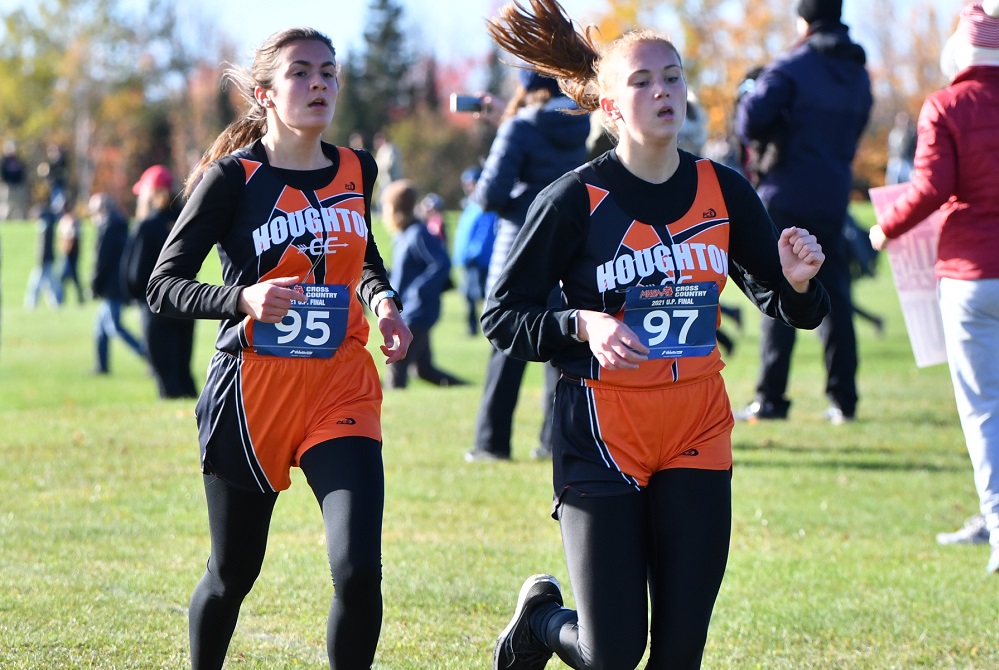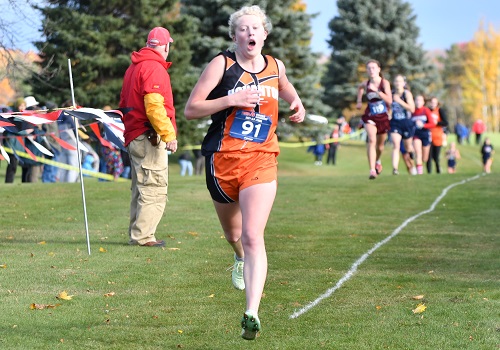
Houghton Girls Overcome Obstacles to Reign Again
By
John Vrancic
Special for MHSAA.com
November 4, 2021
HOUGHTON — Nearly two weeks have passed since the Houghton girls captured their second-straight Upper Peninsula Division 1 cross country title.
 The memories, however, could last a lifetime.
The memories, however, could last a lifetime.
Houghton scored 52 points in the U.P. Final on Oct. 23 at Gentz’s Homestead Golf Course in Chocolay Township (near Marquette), followed by Marquette’s 69, Negaunee’s 83 and Sault Ste. Marie’s 94.
“Overall, it was a pretty good season,” said senior Ingrid Seagren, who was crowned U.P. individual champion for the first time. “I’m grateful I had the opportunity to run. We really wanted to win, and it was exciting to do that.
“This has been a great experience. My teammates and coaches were so amazing.”
Junior Claire Filpus, who missed last year’s U.P. Finals due to COVID-19, placed third in her first championship meet try. “This season was exciting,” she said. “Winning as a team makes you so happy. This was a learning experience. I was a little nervous at first, but I just wanted to see what I could do. I couldn’t run in last year’s Finals, and I know my mom (coach Traci Welch) was upset she couldn’t be there.”
Senior Paige Sleeman went to the Finals as the reigning individual champion. Although she missed time this fall due to illness, she still took eighth.
“I was out three weeks with COVID, but tried to work out on my own,” she said. “I just wanted to try to help our team win its second U.P. title in a row. I knew we could do it.
 “I think beating Negaunee the last couple times was a confidence boost. We’re fortunate to have a lot of kids come out. Some schools couldn’t field a full team. We knew it was going to be tough to defend our title, but we all knew we could win it. Coach Erik (Johnson) told us to run our hardest for 25 minutes.”
“I think beating Negaunee the last couple times was a confidence boost. We’re fortunate to have a lot of kids come out. Some schools couldn’t field a full team. We knew it was going to be tough to defend our title, but we all knew we could win it. Coach Erik (Johnson) told us to run our hardest for 25 minutes.”
This marked the fifth consecutive year Sleeman was part of a U.P. championship team, including three seasons at Chassell and two at Houghton.
Although Welch was unable to attend last year’s Finals, she said COVID had an even greater effect on this year’s team.
“That’s why we lost the (Western Peninsula Athletic) Conference,” she added. “We were a couple runners short. Some of the girls didn’t have the same kind of season as last year, but they all ran their hardest. They handled their nerves well.”
Junior Jewel Laux, who overcame her bout with COVID, ran a personal-best time (22 minutes, 46.1 seconds) at the Finals.
“I hadn’t done a lot of conditioning during the summer, but I like the encouragement I got,” she said. “I didn’t start running until school started. The improvement I made was a highlight. That kind of helped me get better.”
Senior Jaden Serafin said she also enjoyed this season.
“I did okay,” she added. “I enjoyed the camaraderie. Everybody on jayvees and varsity is close knit. It’s fun being on the team. I know a lot of people on the team from the past few years.”
“It was really fun,” freshman Katie Sarau added. “I got a lot of encouragement, and that really helps me a lot. It was really exciting being on varsity, although there were more schools than I’m used to seeing at the Finals.”
The Finals were naturally a learning experience for freshman Kiira Niska as they were for Sarau.
“I was nervous, but it was fun,” she said.
Welch was happy with the way the girls overcame adversity.
“We lost Myah Campioni to a fractured ankle,” she said. “Kiira also had some injury issues, but kind of took Myah’s place and really stepped up. I don’t think Erik and I knew what our Finals lineup would be until after the conference meet.”
 John Vrancic has covered high school sports in the Upper Peninsula since joining the Escanaba Daily Press staff in 1985. He is known most prominently across the peninsula for his extensive coverage of cross country and track & field that frequently appears in newspapers from the Wisconsin border to Lake Huron. He received the James Trethewey Award for Distinguished Service in 2015 from the Upper Peninsula Sportswriters and Sportscasters Association.
John Vrancic has covered high school sports in the Upper Peninsula since joining the Escanaba Daily Press staff in 1985. He is known most prominently across the peninsula for his extensive coverage of cross country and track & field that frequently appears in newspapers from the Wisconsin border to Lake Huron. He received the James Trethewey Award for Distinguished Service in 2015 from the Upper Peninsula Sportswriters and Sportscasters Association.
PHOTOS (Top) Houghton's Paige Sleeman (97) and Ingrid Seagren (95) lead the UPD1 Girls Final at Gentz's Golf Course on Oct. 23 in Marquette. (Middle) Houghton's Claire Filpus takes third place in the Division 1 race. (Photos by Cara Kamps.)

MHSAA Vault: MIS Rose to Challenges to Host 2020 LP Finals
By
Rob Kaminski
MHSAA benchmarks editor
November 12, 2021
The “MHSAA Vault” features stories from past publications and other documents in the MHSAA Library. This issue takes a look at the MHSAA Cross Country Finals at Michigan International Speedway, which celebrated 25 years in 2020 – although it was an event that nearly didn’t happen last fall …
In 1996, the MHSAA and Michigan International Speedway began a partnership the changed the course of the Lower Peninsula Cross Country Finals – quite literally.
The land in and around the track at Brooklyn would host the Finals for all classes of runners in one place on one day, an annual festival of nearly 2,000 runners competing for the MHSAA’s top honors.
Even skeptics – and there were several among running purists who thought the course was too flat, for example – can’t deny the results.
Finals attendance nearly doubled in that first year, and crowds in excess of 10,000 have enjoyed a day of racing several times, including a record 12,153 in 2011.
Enthusiastic crowds were the norm in recent years, with 11,232 in 2017, and nearly 11,000 in 2018 (10,989) and 2019 (10,873).
In fact, attendance failed to reach at least 8,000 only twice since the move to MIS.
Of course, last year was an exception, when attendance was limited to 1,000 spectators per session due to the COVID-19 Pandemic. Fans also were restricted to the grandstands rather than following the action throughout locations on the course.
To reduce the number of runners in each race, the event was spread over two days, with each Division being run in two separate “sections” with times then combined at the end to determine team and individual champions.
While not ideal, the end result was another year of fantastic efforts at MIS – both from student-athletes and those behind the scenes.
“Even at the last hour, less than a week ahead of the Finals, we were closer to not having the Finals than we were to having them,” said MHSAA Assistant Director Cody Inglis, who coordinates the cross country postseason. “Rumors and challenges of mandated shutdowns, testing and other requirements were being discussed and caused a lot of unknowns. Even at the Regional level, we had schools, Regional courses and hosts shutting down their facilities; we had to relocate four Regionals 48 hours prior to race times. That scenario just could not happen at the Finals level where far more runners and much more travel would be involved.”
Among the many last-minute hurdles was the edict from NASCAR – which owns MIS – that all persons on site be temperature checked upon entry. That meant securing thermometers that were easy to operate in short order, along with personnel necessary to conduct the readings.
The attendance limitations certainly helped to implement the temperature screening, but brought their own issues.
“Limiting spectators was not a popular decision, but it really was the only way to have a race,” Inglis said. “We were taking direction and working with policies and protocols from the MDHHS, the Governor’s office, Lenawee County Health Department, MIS and NASCAR.”
Part of the solution was to utilize the grandstands as a “barrier” between participants and spectators. The reduced number of fans were dispersed over thousands of seats while still allowing them the chance to watch their student-athletes compete.
“It wasn’t the same, it wasn’t easy or perfect, but it was what we had to do to have a race,” Inglis said. “Separating the Finals into two days and different sections also allowed us to spread out the event and limit the number of people on site at any one time. This was a key part of the plan and worked well even though it separated races within a Division.”
The MHSAA, MIS and the cross country community never lost focus of the main goal: a culmination of the season for the student-athletes, who deserved something last year more than ever. And, more than ever, MIS once again displayed its advantage as a venue that could adapt to the fluid nature of the times to pull off the event.
“There were some thoughts of using four different sites, but as we learned during the Regionals, the climate of things was so tenuous from one area of the state to another that we couldn’t be 100-percent certain that there wouldn’t again be last-minute cancelations,” Inglis said. “MIS was wonderful to work and collaborate with, and was the best option to get it done. It was never mentioned once publicly about the possibility of not having the Finals – only how we could best do it under uncharted conditions.”
The moving parts and ever-changing scenarios created more complexity than ever in finalizing a season, but every decision was made with the complete desire to conduct the Finals as close to normal as possible.
“I firmly believe that a finish to the season, no matter the differences in race formatting and fan experience, was something everyone would have taken when the season began in August,” Inglis said.
Indeed, the finish line in Year 25 at MIS might have been the most gratifying of them all.

